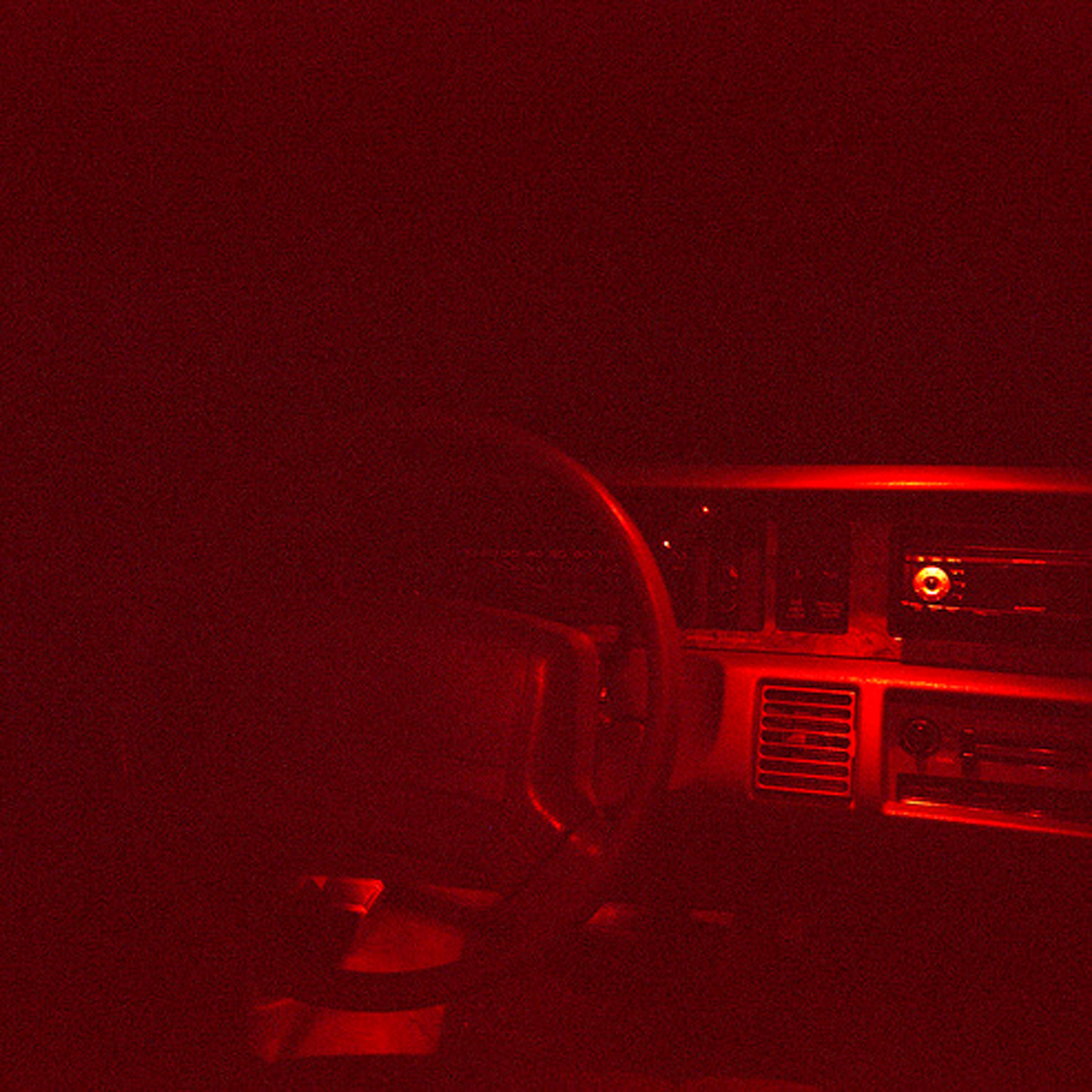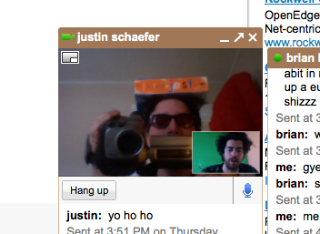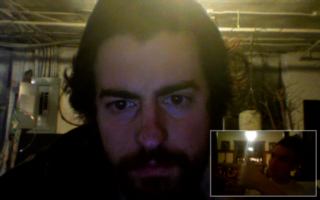How to Make a Conceptual Art Show
A five-way interview done via IM with the artists behind the high-concept show, CAPRICE, opening at Art Of This Gallery on May 9. Ruben's question -- so, what the heck are you planning to do? -- is straightforward. It turns out the answer is anything but.




An iChat by artist Ruben Nusz with Vena Ambrose (Mpls), Sayre Gomez (LA), Justin Schaefer (Mpls) and J. Patrick Walsh III (NYC), the artists behind Caprice, an upcoming installation and exhibition at Art Of This Gallery opening May 9 and on view through May 30.
***
ruben: Thanks to everyone who’s participating in this five-way chat. Please answer my questions at your leisure. Let the conversation flow naturally.
ruben: Okay, so lets put this project in context. Could you describe what you’ve been working on that will culminate in Caprice, the exhibition at Art of This the opens on May 9th? (See below for a trailer the artists made for the exhibition.)
sayregomez: The exhibition, I think, will be an interesting attempt at setting up some very simple parameters each of the four of us will be working within together – the foremost of those parameters being that of time. All of us have committed to making the work on-site.
justin: The epipheral experience, the short-lived enlightenment.
ruben: Could you elaborate on what you mean by “the epipheral experience?”
sayregomez: Justin made this phrase up…
justin: Epiphany+ephemeral=epipheral: a short-lived enlightenment in real time.
vena: Time is very exacting.
ruben: What do you mean by “real time?” Isn’t everything in real time?
johnpatrickwalsh3: It can feel like an eternity…
justin: It’s the super present.
ruben: Infinity in a second? How will this happen? That’s an ambitious agenda, especially given the fact that, say, Buddhist enlightenment takes a lifetime to achieve (if it happens at all).
justin: We’re interested in speeding time up to slow it down.
johnpatrickwalsh3: Then there is heavy time.
sayregomez: Oh boy…
ruben: Is there a way of pulling these phrases you’re giving me from the abstract ether and into something more tangible?
johnpatrickwalsh3: The experience in the show will not be like enlightenment exactly.
justin: My imagination led me to think that working in a shorter amount of time would lead to us having to make decisions that were NOT based on an overarching strategy, but which were based more around a way of working. A more intuitive, spontaneous way of working.
sayregomez: I think when I was talking about time I was talking about it in a more literal sense, in that for most of the work that we will be showing, the objects that the viewer experiences will be have been made quasi – collaboratively and within a very short amount of time.
ruben: Are you using new media in the exhibition, or just in the preparations? When all is said and done and I walk into Art of This, what will I see? Sculpture/2D work/etc…
johnpatrickwalsh3: The work will be more cinematic and automatic.
justin: We don’t intend this to be an experiment, but it is an intuitive process. We trust our way of seeing and describing the world.
ruben: How is this going to be different from work by other installation artists who work on-site?
justin: We’re allowing it to become a shared language, and keeping it personal.
sayregomez: But we aren’t necessarily talking about a collective…
justin: We’re allowing the “viewer” and “artist” relationship to work together in tandem…we are NOT a collective.
justin: This needs to slow down…SLOW MOTION, TO SPEED UP
ruben: How do you plan for the viewer and artist work in tandem?
sayregomez: We all know each other well and are interested in each other’s work and ideas. We’re using the exhibition as vehicle to see what we can do together, and how this interaction will affect our practices and the objects we produce for the show.
ruben: @Sayre, are you saying you’ll use the other artists’ methods and work to alter your personal practices?
sayregomez: It’s possible, yes.
ruben: What type of works do each of you make now, and what do you hope will come out of this collaboration?
johnpatrickwalsh3: I think that the timing of the exhibition, along with this type of communication, is linked to the kind work that we already make, but individually…
sayregomez: One thing that I am interested in is collage — and I mean that in the broadest sense. So I think we could think of that as a way of approaching and framing the show.
justin: I don’t make artwork for shows, I make art shows.
sayregomez: Ha! That’s clever.
ruben: @justin, How is that different than being a curator? You’ve mentioned this before, and I’m still not buying it.
justin: Well, its not for sale. But let me break it down again…
sayregomez: Justin is using curation as part of his practice and including himself as the largest proponent of his curatorial vision
justin: Here, let me try. The best answer I have for you, Ruben, is that I’m an artist, not a curator. And this is my art.
ruben: But why the aversion to the label “curator?” Is a curator inferior, in your mind, to an artist?
Justin: Ha! Not at all, but a curator has a different kind of ambition, one that requires a certain kind of interest that I don’t share.
ruben: But isn’t “curator” just a label for a type of artistic action of selecting artists to exhibit together? What elements of curating do you oppose?
justin: I like to think of Art of This as my sculpture. We are its working anatomy, as are the viewers, working in tandem to create it.
sayregomez: I think that’s a great way to think of what this show will be – Art Of This Gallery as “sculpture”.
vena: Like “I may be jarred but I am certainly not a bug”
ruben: This is interesting. From my past experience with David Peterson, it appears he’s very enthusiastic about the social elements in creating art in the space (AOT), for example in the gallery’s work with the group Hardland/Heartland. Have you engaged with Peterson thus far about what specifically you’ll do? Will the viewers function on the same level as the artists or the gallery? Is that even possible? I mean, most viewing is passive. Relational aesthetics create more active viewers, but how will you weave this into the exhibition?
justin: Dave (Peterson) has allowed me to say a whole lot about our plans without saying anything at all. “Bits and pieces put together working together to create a semblance of a whole” -Lawrence Weiner
________________________________________________________
I think we’re talking about creating a kind of sublime sensationalism — where once the viewer is engaged, they become a part of the work in a metaphysical sense.
________________________________________________________
sayregomez: I’m not sure that this will include people the way relational aesthetics does exactly…
ruben: So how are you creating active viewers?
justin: By creating the moment for them to create for themselves.
ruben: So the viewer will create in the space as well?
justin: In tandem with us.
johnpatrickwalsh3: wanderlust
ruben: How?
johnpatrickwalsh3: scented whips
ruben: 🙂
justin: The same way they have for ages, just by being provoked in a different way. THEY WILL KNOW.
johnpatrickwalsh3: and deconstructed mini-malls
johnpatrickwalsh3: sweat
justin: I can’t reveal the evidence. We’re already building expectations to deliver on.
ruben: New direction: Sayre, you’re in L.A.; Patrick’s in Brooklyn. How do these locations inform your practice? What can Minnesota artists learn from LA/NY artists?
justin: People will recognize that this is a different kind of experience than they are used too.
sayregomez: I think Justin is talking about creating a kind of sublime sensationalism with Caprice. If the viewer can engage with what they see, then they are no longer just passive viewers. They become a part of the work, in a metaphysical sense.
justin: I trust that I know how this will work, that’s all. We have done this kind of thing before. I think Sayre is right.
johnpatrickwalsh3: I feel like it will be a real-time cinema.
sayregomez: But that doesn’t help much in the way of giving information about the show for an interview, does it?
ruben: 🙂
justin: IS this an interview?
ruben: I’m just trying to give readers something to cling to. This isn’t an interview, it’s a conversation. Right?
justin: I assume this conversation has the same potential to engage people that the show has, which is why we wanted to handle the interview this way.
sayregomez: Right, right.
justin: This conversation/interview could fail as well as whatever the other thing in the gallery turns out to be.
ruben: @Justin — is much of this about potential? Like potential energy, that just isn’t…executed?
justin: I think of it more as evidence, or telling a great story — one that sends your mind into a space where it then creates a visual. It’s being excited but not really being able to believe, and then, smack! You see the real, the evidence.
johnpatrickwalsh3: Portals to move thru as gesture.
vena: It is all hairy.
justin: It’s evocative, like a crime scene or dead soldiers on TV.
johnpatrickwalsh3: That is how the space will evolve.
ruben: @Justin — But how is this any different than other art exhibitions? Isn’t that potential there for everything? How are you directing attention to that kind of potential other than simply mentioning it here?
justin: Like I said….the work isn’t made yet. NONE of it. The work will be created, all of it, in Minneapolis 4 days before Caprice opens.
ruben: I’m still confused, if you’re not a collective, how does everyone function on the same level?
sayregomez: I think one thing that sets us apart, is that we are all essentially studio-based artists.
johnpatrickwalsh3: But we work spontaneously.
ruben: Does conflict between you inspire the work?
sayregomez: Well – I think it will, when we are all there together.
johnpatrickwalsh3: I think this brings up more relevant issues…
ruben: The title “Caprice” is vague, by definition. Can the viewer’s experience ultimately be rewarding when the idea behind the show is so diffuse? Isn’t that precisely what turns many viewers off from rigid conceptualism?
justin: This isn’t conceptualism. This isn’t an experiment.
sayregomez: Well, what is rewarding?
ruben: Lots of art is rewarding!
johnpatrickwalsh3: The obscure and vague is what is interesting.
sayregomez: I think that conceptualism is having a huge renaissance right now. Smart is sexy.
justin: We are making an art show in 5 days. Period. We are just speeding up the studio practice.
ruben: Isn’t being vague and contradictory often a cop out, though — something played in lieu of creating something difficult, but also cohesive? I’m not saying this is necessarily the case here, I’m just asking.
justin: But we are paying attention to all of the things that you would hope to when creating any other kind of work. How is that vague?
sayregomez: The funny thing about conceptualism is that it set out to de-materialize the art object, but what it actually did is just make EVERYTHING sellable as art!
ruben: @Sayre — It’s capitalism and, in a battle between capitalism and anything else, capitalism wins…for now.
ruben: So how will the work be cohesive? Is cohesion even important?
sayregomez: Yeah, it is.
justin: SLOW DOWN.
johnpatrickwalsh3: But there is a lot of vague grey matter.
justin: The work will be cohesive because we will command it to….
ruben: You’ll command it?
justin: We’ll command it of ourselves in the practice of making the show.
johnpatrickwalsh3: And that’s what I mean by “vague.”
justin: And we’ll command it of the viewers through the practice of putting it in front of them. It’s bricolage in practice. We have come to define this as the act of borrowing methodology, nomenclature, questions, problems, etc. from disciplines or structures without adopting the rules that govern those said disciplines or structures.
________________________________________________________
I’ll bet you $50, no matter what else you’re calling it now, when I come to the gallery I’ll see some sculpture.
________________________________________________________
ruben: Bricolage. No rules. But isn’t showing in a gallery itself following the conventional protocol? And won’t you be making “sculpture?”
sayregomez: That’s funny
justin: I’M NOT SURE RUBEN WE HAVENT MADE IT YET!
ruben: I’ll bet you $50 I come to the gallery and see sculpture.
sayregomez: Hahahaha
ruben: 🙂
sayregomez: We might have live tigers on pedestals.
ruben: @Sayre – that sounds like sculpture to me!
justin: Ruben, let me ask you a question: Why do you persist in asking questions about the work, when you know now and have known that the work hasn’t even been made or thought about yet?!
justin: You know you read the proposal.
This is supposed to be VAGUE
That’s what it is
It’s heightening the moment
Raising expectations
Almost cumming
Just the tip
ruben: @Justin — I’m a determinist! I’m also trying to glean some idea of what the show will be about even if you guys don’t know exactly what you’ll do yet. And, despite your protests, based on what you’ve said I still suspect the work will follow established artistic protocol.
johnpatrickwalsh3: whip
justin: What protests? It will be an art show. I’m making an art show.
ruben: PS: I’m having a fantastic time right now. Is this the epipheral? Can you do this with all the viewers? You should!!!!!!
sayregomez: How do you define artistic protocol?
justin: At the Art of This, they don’t even know.
sayregomez: And yes, the show will feature art.
ruben: Examples of protocol: showing in a gallery, for one.
justin: The gallery directors have no idea. We have no idea. We commanded this moment. What happens… we will see.
sayregomez: Exactly – we never claimed we were attempting to rework the entirety of art history.
ruben: Again, I’m a determinist: we command nothing!
justin: That’s the difference between curators and artists, and between our work for Caprice and what has been shown in other exhibitions like this: Dave (Peterson) has no idea what to expect and neither do we. The proposal we sent them said practically nothing. I don’t know where this will end up. That’s where we are now.
ruben: But you do have an idea what to expect. If I Google Sayre, Patrick, Vena, etc — I find examples of your previous work. This helps to put things in context. But at the same time, you’re telling me I’m doing the impossible by trying to milk some idea of what the show’s about, when you have no idea. Correct? Yet, I would argue that, while this creative process is fascinating, the end result will probably follow conventional artistic protocols.
justin: This is true!
I’M MAKING AN ART SHOW
I MAKE ART SHOWS
ruben: 🙂 Yes!
sayregomez: I think, Ruben, our main intention is not to play into the modernist anticipation of what is new. We aren’t interested in how we can reshape the future of art-making.
ruben: Isn’t all art about the unexpected, though? This conversation was unexpected, but will the exhibition be this novel?
justin: I would hope so, but I don’t know what to expect.
sayregomez: I want to see what happens when we all come together with no predetermined established rules about what we will make, and I’m eager to see how we all work together in person.
justin: Yes, that’s what I’m excited about as well. I would rather see us trying to accomplish something through a neutral approach, one that strips itself of strategy, one that has the chance to fail – to do something spontaneous, that isn’t curated ahead of time.
ruben: This sounds like a wonderful show. I’m really excited to see what happens. May 9th?
sayregomez: We are, too.
ruben: Thanks everybody! See you soon.
*****
About the author: Originally from South Dakota, Minnesota artist Ruben Nusz was raised by cowboys and later graduated Summa Cum Laude from the University of Minnesota. In 2003 Nusz directed a feature-length documentary that toured the festival circuit. He has exhibited mixed-media works at the Minnesota Museum of American Art, Rochester Art Center, Rosalux Gallery, Umber Studios and the Hopkins Center for the Arts. He is one of the co-founders of SELLOUT Gallery, an artist-run space devoted to the exhibition of work by emerging and mid-career artists as well as independent curators.